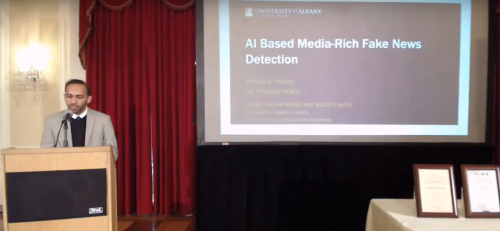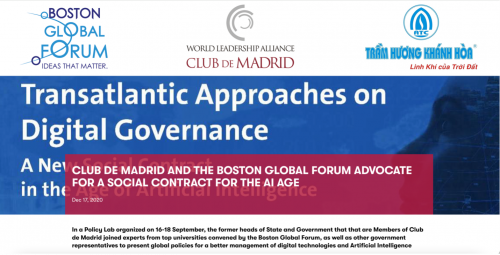On December 12, 2018 Shivam Parikh, University’s College of Engineering and Applied Sciences presented the result of his work with Associate Professor Pradeep Atrey, University at Albany on detecting fake news in the event of the Global Cybersecurity Day 2018, is organized by Boston Global Forum (BGF) and Michael Dukakis Institute (MDI), at Loeb House, Harvard.

The authenticity of information has become a longstanding issue affecting businesses and society and many researchers around the globe have been trying to understand the basic characteristics of the problem. Shivam Parikh and Pradeep Atrey’s study looks at the challenges associated with detecting fake news and existing detection approaches.
“Fake news can be any anything that is designed to change people’s opinion, convince its readers to believe in something that is not true,” said Parikh, who works as a systems developer analyst for ITS at University at Albany. He showed some specific examples of fake news and emphasized the serious impact of this growing problem “with the social media on the rise, fake news stories are very reachable and have a very high impact factor.”
At the same time, Parikh presented a categorization of some existing potential approaches, their key characteristics and their respective advantages and limitations. Methods mentioned are:
- Linguistic Features based Methods: The approach is about using/extracting key linguistic features from fake news;
- Deception Modeling based Methods: The process of clustering deceptive vs. truthful stories relies on theoretical approaches;
- Clustering based Methods Clustering: a known method to compare and contrast a large amount of data;
- Predictive Modeling based Methods: this method follows a logistic regression model based on training data set of 100 out of 132 news reports;
- Non-Text Cues based Methods: this mainly focused on the non-text content of the news content
In conclusion, the researcher highlights 4 key open research challenges that can guide future research on fake news detection:
- Multi-modal Data-set: This opens up an opportunity for researchers to create a multi-modal data-set that covers all the fake news data types.
- Multi-modal Verification Method: This calls for verification of not just language, but images, audio, embedded content (i.e. embedded video, tweet, Facebook post) and hyperlinks (i.e. links to different URLs).
- Source Verification: Source of the news story has not been done in proposed existing methods, this calls for a new fake news detection method that can perform source verification and considers the source in evaluating fake news stories.
- Author Credibility Check: One of the methods proposes that detecting tone of a news story to detect fake news, research challenge could be that author credibility check allows system to detect chain of news written same author or same group of authors to detect fake news.
Parikh continues working on these issues and he believes better understanding in the field will assist in improving the accuracy of the detection of fake news and misinformation in the future.










